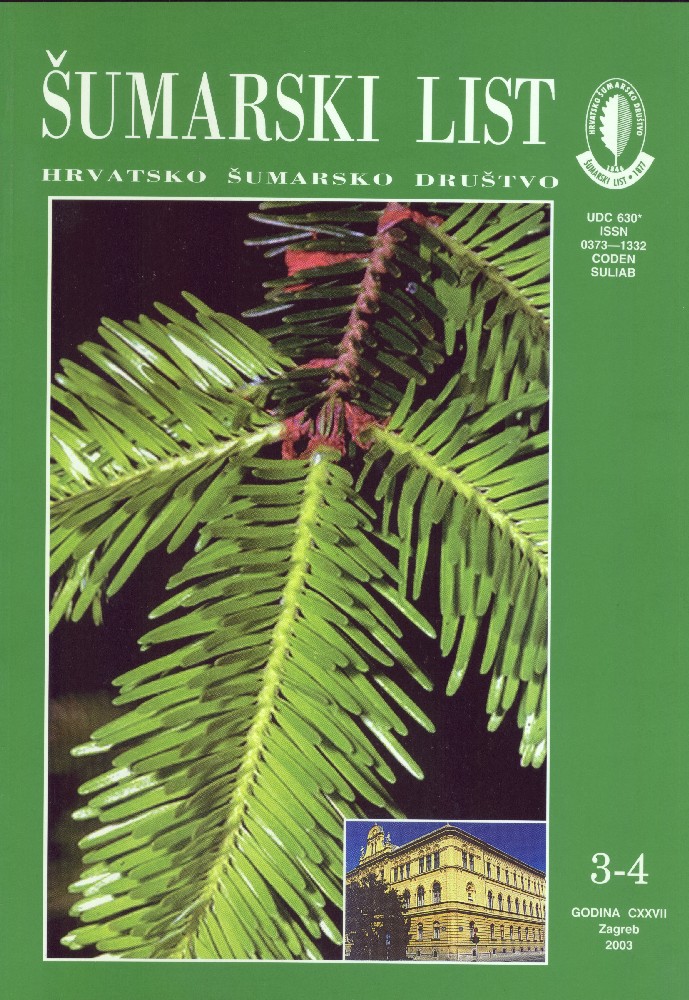
broj: 3-4/2003
pdf (28,3 MB) |
|
||||||||||||||
| IZVORNI ZNANSTVENI ČLANCI | ||
| Margaletić, J., Glavaš, M., Pavić, K. | UDK 630* 451 (001) | |
| The Numerousness of Small Rodents and their Harmfulness in the Management Unit of “Južna Krndija I (Kutjevačka)” and in the Nursery “Hajderovac”. pdf HR EN | 99 | |
| Križanec, R. | UDK 630* 612 + 613 (001) | |
| New Variants of Time Management of Selection Forests pdf HR EN | 109 | |
| Summary: In selection forests time is an economic management indicator with no alternative. Although measurable, it has not been adequately evaluated and incorporated in prognostic models of development and future management. The problem of mid- and long-term management planning aimed at achieving multipurpose progressive yield sustainability within the limits of sustainable development of forests that grow "in continuo", that is, permanently, has directed our research of many years to studying time management. This issue forms the key point of the majority of past, as well as this work. By monitoring and recording changes in the growth of a forest in one management unit, new insights into particular features of selection forest development which enable mid- and long-term planning have been established and presented in this paper. The processes and the length of development of wood mass of individual trees are long-lasting and limited in time by physiological maturity. The processes and duration of the development of the growing stock making up the wood mass of these trees are permanent and take place "in continuo", in closed integral circles or cycles. In a normal selection forest one integral cycle in the development of growing stock takes up three average transition times (3Ts) for a stand as a unit. In terms of duration it equals a management cycle, in which the amount of annual yield equals the increment of a normal growing stock (V) but in such a way that the other growing stock of the same size remains on the stump as a new increment reproducer in the new cycle. Three consecutive management cycles in a series form a development period or management conversion period. In the course of period duration in time (3x3Ts=9Ts) wood mass amounting to three normal growing stocks (3V) are obtained in the three cycles, while the fourth remains on the stump in the forest. The equilibrium of natural diversity of forest bio- and ecosystem is realised through a continuous coordination of triple relationship: growing stock- increment - yield. Based on new insights into a continuous sequence of cycles and the possibility of direct measurement of the time needed to fully utilise normal growing stocks of a selection forest, a new formula for determining a normal annual yield by purpose and form was set up, which is identical to Masson-Wattier´s formula for the entire yield in a high regular forest: However, the denominator contains a variant of the management component "time" (9Ts), adapted to the system, permanent development and age heterogeneity of selection stands. A nine-fold average transition time for a stand as a whole (9Ts) is a counterpart to rotation in a high regular forest. It defines a new time constant: fictional rotation or management conversion period applicable to managing selection forests (u = 9Ts). With regard to their scientific origin and simple form, the new yield formula and fictional rotation are in practice easily incorporated in the existing forest management models. Being effective signs of cutting maturity, we propose their use for the calculation and control of account and yield realisation in all units of spatial division of selection forests Key words: selection forest; time management; transition time; cycle; thinning; period; mid- and long-term planning; fictional rotation; yield | ||
| Ballian, D. | UDK 630* 165 (001) | |
| Estimate of the Genetic Variability of Silver Fir (Abies alba Mill.) by Analysis of Isoenzymes in the Part of Natural Populations of Bosnia and Hercegovina and Croatia pdf HR EN | 135 | |
| PREGLEDNI ČLANCI | ||
| Vojniković, S. | UDK 630* 188 | |
| The History and Recent Problems of the Phytocoenological Nomenclature and Classification pdf HR EN | 153 | |
| STRUČNI ČLANCI | ||
| Margaletić, M. | UDK 630* 931 + 891 | |
| The Exploitation of Mineral Raw Materials in Relation to the Forest and Forest Land pdf HR EN | 161 | |
| Nodilo, J. | UDK 630* 432 | |
| Fire in the Open Space of the Islands and Littoral - Accident or a Logical Sequence of Events pdf HR EN | 171 | |


